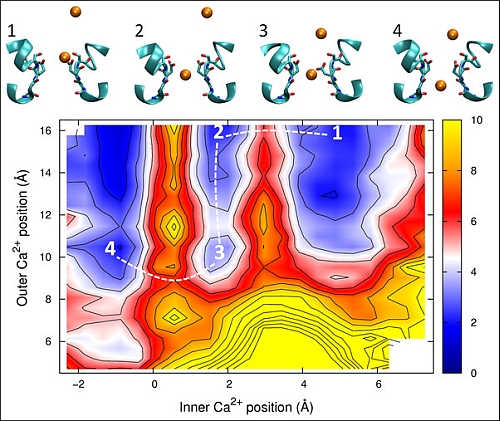The ability to distinguish between different ions such as sodium, potassium and calcium is critical to the function of many biological molecules and has been a topic of considerable intellectual debate for more than 50 years. The determination of a number of protein structures in the last 10 years has allowed for a better understanding of how this can arise in specific cases.
In a well-received PeerJ article “Na+/Ca2+ selectivity in the bacterial voltage-gated sodium channel NavAb” published last year, Dr. Ben Corry used computer simulations to try to understand how a sodium selective membrane protein, known as a voltage-gated sodium channel, can allow sodium to pass while preventing the passage of calcium.
His research highlighted that this results from the cost of dehydrating calcium ions being less well compensated by interactions with the protein than is the case for sodium. Many molecular level explanations of selectivity were put forward before structural information was available by careful interpretation of macroscopic experiments. Remarkably his results echo many of these theories indicating how insightful much of the early research in this area has been.
As a year has passed since that publication, and as many citations are now accruing, we wanted to check in with Dr Corry to see where his research was now headed.
He told us that “without a doubt this research has fed into the growing research effort in this area. There has been a big spike in research in the area of ion channel function since the publication of the structures of a number of sodium channels, as this provides the starting point for understanding how this fundamental biological process takes place. The PeerJ publication was one of the first to make use of this information to understand selection between sodium and calcium, and it has received quite a bit of interest at conferences and by correspondence. Most experimental information about ion selectivity has been obtained for eukaryotic proteins, which differ significantly from the bacterial ones studied here, and examining detailed properties such as ion solvation in simulations is notoriously difficult. Thus, there is some justified uncertainty about the universality of the results obtained here, but it provides a plausible and concrete explanation for how sodium/calcium selection can arise.”
Dr. Corry, who studied physics at the Australian National University before turning his attention to the basis of ion selection in sodium channels, is now focusing on understanding how these proteins function as drug targets. Regarding his ongoing work, he said: “Since most local anesthetics and anti-epileptics work by blocking sodium channels, we are keen to understand the mechanism of action of these drugs so as to guide the design of new therapeutics. In addition there are many questions as to how selection arises in sodium channels that remain to be answered – not least to understand the differences between how it occurs in human proteins compared to bacterial ones.”
We hope to read more on Dr. Corry’s research soon!


